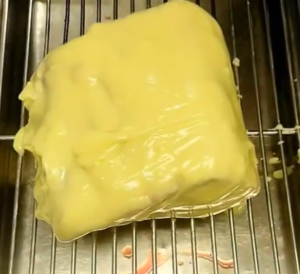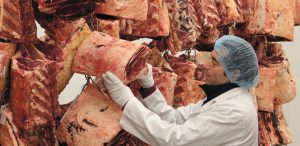Chef Ages His Steaks In Logs Of Butter
Yep…you heard that right.
 A trendy first class respected chef in Denmark at the Marienlyst Strandhotel is using his unique method to age his beef in butter.
A trendy first class respected chef in Denmark at the Marienlyst Strandhotel is using his unique method to age his beef in butter.
After Chef Casper Stuhe Sobcyk (instagram) prepares the meat he then submerges the cut into a bath of softened butter and then allows it to rest and age for a specified time that meets his requirements. Chef Casper states that he leaves the meat ageing for at least 30 days. The meat is in-cased in a thick coat of butter and has an appearance of a large yellow cocoon.
 While most meat connoisseur or people that enjoy their meat in general, the wet ageing and dry ageing methods has always worked out fine, there always is an understanding that ageing meat will have some yield loss aspects due to the process. But the end result is well worth the effort with an enjoyable eating experience that garnishes flavoursome tones from the process and of course that extra melt in the mouth tenderness that happens to the meat as its natural enzymes break it down.
While most meat connoisseur or people that enjoy their meat in general, the wet ageing and dry ageing methods has always worked out fine, there always is an understanding that ageing meat will have some yield loss aspects due to the process. But the end result is well worth the effort with an enjoyable eating experience that garnishes flavoursome tones from the process and of course that extra melt in the mouth tenderness that happens to the meat as its natural enzymes break it down.
How Does The Butter Ageing Work?
You might be wondering how it all works? It might be better if I first quickly explain the other two methods of ageing.

Dry Ageing is exactly that…drying the meat out as it ages. The meat sits on a rack or hangs on hooks and rails in a temperature and moisture controlled storage fridge for a length of time. The meat primal forms a crust and stops further moisture evaporation and just lets the natural meat enzymes break the muscle down and intensify the flavours. You can read my in-depth article HERE where I talk about the process with a bit more technicality.

Wet Ageing is where the meat is vacuum packed and then it is allowed to sit in a carton or rack for a specified length of time in a storage fridge. There is now no moisture evaporation as the bag forms a barrier (obviously) but as the natural meat enzymes still break the muscle fibres down the bag accumulates with blood and juices around the meat piece. The meat sitting in these blood juices can some times give the meat the metallic taste but it doesn’t always happen.
So with Chef Casper’s Butter method it is similar to the dry ageing except there is none of the black dry crust formed on the meat surface. The butter acts as the barrier and the blood juices remain in the meat muscle but the natural enzymes still break the fibres down to create the tender meat. The meat flavours still intensify and I would imagine the meat would also absorb some of the rich butter flavourings as well. I haven’t had the opportunity to taste any of Chef Casper’s Butter Aged Steaks (it’s certainly on my to do list) but I would think that this would happen also.
Below is the finished result…

You can see the succulent steaks still intact and the same original size. The butter has eliminated shrinkage and very little if not any trimming is required.
In all methods the enzymes are basically using the time to help deteriorate the meat in the same manner as decomposition of any natural organic item be it meat, fruits, vegetables or an animal when it dies. Nature at work.
Over all in my opinion, as a butcher, I think Chef Casper Stuhe Sobcyk has developed a unique, interesting and wonderful method of preparing a beautiful piece of meat. I really enjoy finding and learning about new, different, artistic and out of the box thinking for meat preparation and the meat industry in general.
I hope you enjoyed my article and why not have a go at Butter Aged Beef. I am sure you will get the tasters commenting.
Feel free to leave a comment and share to your friends.
John

Can ya do a rub before the butter bath or not ?. And do ya use the left over butter after the aging process is done ?
Hi Dale, you could use a rub but the idea of aging beef is to enhance the natural beef flavouring. If you add seasoning and salt to the meat the end product would turn out like a cured cold cut similar to a Coppa (air dried pork neck) or Beef Bresola (air dried beef cut). And that all depends on the aging time factor as well. You could still slice it and cook it though. With the re-use of the butter, I would only recommend using it for cooking purposes like melting it in a frying pan or BBQ plate then cooking your steak or veggies. Reason being that the raw meats enzymes and natural bacteria could end up in the butter so I wouldn’t recommend using the butter as a spread on bread or toast for health safety. I hope I’ve answered your questions and if you do try out the seasoned aging let me how you go and feel free to send a few pics of the end result either here or to my email john@askjohnthebutcher.com
Cheers
How is this different from wet aging? The meat is encased in an air sealed environment and left to age. Moisture is maintained and therefore this doesn’t concentrate the beef flavor. Plus now you have the cost of lots of butter. Enzymes work the same as if it were encased in plastic…unless I’m missing something. Please clarify. Thanks!
Hi Shane, thanks for reading my article and your question. Yes, the meat is encased but the sealing takes place in a few days. Casper firstly stores the meat on a rack without coverage for a few days before encasing in the butter and it dries out any excess moisture a little. Butter, being natural, has water content in its make up, so being directly exposed to the air flow without coverage or wrappings (as butter is normally stored) there is still evaporation of the water/moisture from the butter and meat for a few days before the butter completely hardens and seals, albeit at a slower rate of evaporation for the meat than normal dry ageing. The moisture can still escape unlike the plastic from a vac bag. The salt in the butter also draws out moisture from the meat and in the last image you can see discolouration on the outer layer of the meat. This is from the chemical reaction with the salt on the meat.
Yes the butter is an extra cost factor but in normal dry ageing, during the process the meat forms the dry black crust causing heavier trimming when ready for preparation, but with Caspers method the crust is the actual butter, eliminating the wastage with minimal or zero trimming from the meat primal. Butter costs less than meat and there will be greater yield from the finished product of steaks perhaps getting an extra steak to sell instead of discarding the meat trimmings. So I guess it could be a bit of a payoff. Regardless, there is an added cost with using the butter but I am sure that Casper has factored in the extra costings for his end plate. Plus a great marketing item for the hotel which could command a premium price for the plate.
Hope that has clarified your query and thanks for stopping by.
John
Butter does not have water in its contents. If it did, it would defeat the purpose of sealing the steak.
I Stand corrected there is some water in butter.
This is wet aging – nothing else. Do a side by side test where you do the same things except you vac one piece of meat and put the other in butter. The result is identical (except for a very little leftover taste from the fatty acids and salt in the butter).
I tested it myself several times (and I have also tasted Caspers steak) and the result is nowhere near a real dry aged steak.
when butter aging individual steaks i noticed a little blood coming through the top of the steak the first day or so. is this normal?
Hi Scott, Thanks for reading my article.
It is not uncommon for this to happen. As the meat is encased in the butter, the small amount of salt content in the butter can cause some blood weeping (as we call it in the industry). What Casper does, is leave the meat uncovered to dry out a little in his chiller for a few days before encasing in the butter. This reduces the blood content in the meat. Hope that helps.
Regards John
Thanks ❤️❤️
Hi Casper, thanks for stopping by.
Can you use any cut of steak?
Hi Melissa, thanks for dropping by and reading my article. Short answer is, yes. You can use different primal cuts but the Ribeye is commonly used because of its tenderness and flavour enhancement properties. Also it only has fat inside to muscles and not a coverage fat like the Striploin. Cuts used for Dry Ageing the conventional method are Striploin, Rump or Shortloin for the name in US. These cuts have fat covering one section of the primal giving the meat protection and the fat is trimmed off quite heavily when ready. In my opinion, covering a primal with butter that has a fat covering already is a bit of waste but that doesn’t mean it can’t or shouldn’t be done. Thanks John
Hi John
Can you advise the best way to cook a butter aged steak? We have a weber bbq that we would like to use for it. Thanks
Hi Claire,
Thanks for visiting my site and article. You can treat the steak as you would normally and either panfry, bbq grill and even roast if you like. The ageing in butter will just enhance the flavour with the added benefit of tenderness. You can even use the butter for cooking if you like. Your Weber BBQ would be an excellent choice. I have an article on cooking the steak on this link Cooking Perfect Steaks – My OK Method which will give you a few tips on how to check the steak for doneness to your preference. I hope it helps.
Enjoy and regards John